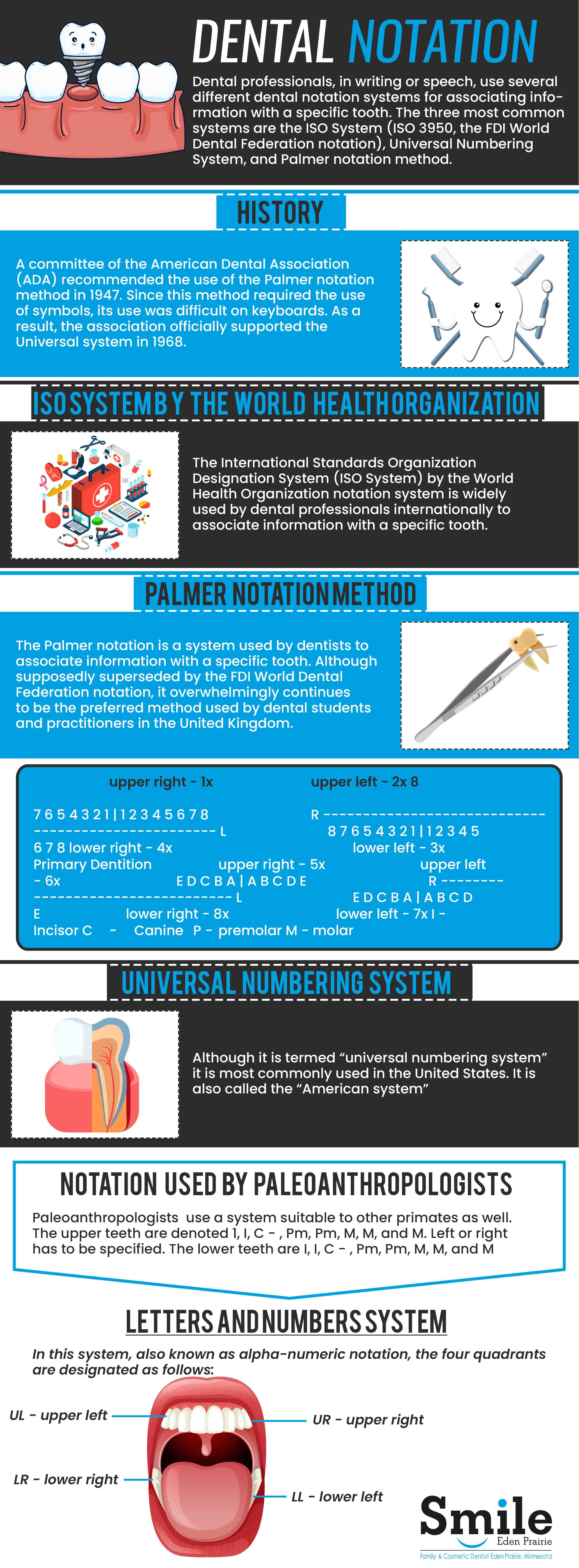General Dentistry Concepts: Dental notation
Dental professionals use numerous dental notation systems to efficiently associate information with a specific tooth. The three most popular systems used include the ISO System, Universal Numbering System and the Palmer notation method. The ISO system is used throughout the world and the Universal system is widely used across the United States. In addition, the ISO System can easily be adapted to charting on a computer.
History
In 1947, a committee of the American Dental Association (ADA) suggested the use of the Palmer notation method. Because this method uses symbols, it is difficult to use on keyboards. Due to this challenge, the association officially supported the use of the Universal system in 1968. In 1996, the ADA officially adopted the ISO System as an alternative to the Universal System.
ISO System by the World Health Organization
The International Standards Organization Designation System (ISO System) notation system is widely used internationally by dental professionals. It associates information with a specific tooth. The Fédération Dentaire Internationale (FDI) also refers to it as the ISO 3950 notation. The ISO System uses a two-digit numbering system where the first digit represents the quadrant of the tooth and the second digit represents the number of the tooth from the midline of the face. The numbers associated with each quadrant of permanent teeth are:
- 1: the upper right section of teeth
- 2: the upper left section of teeth
- 3: the lower left section of teeth
- 4: the lower right section of teeth
For primary teeth, the number sequence goes 5, 6, 7, and 8 for the teeth in the upper right, upper left, lower left, and lower right respectively. When referring to a specific tooth such as the permanent maxillary central incisor, the notation is pronounced “one, one”.
Palmer notation method
The Palmer notation system is often used by dentists to associate information with a specific tooth. Although the FDI World Dental Federation notation was intended to supersede the Palmer notation system, it continues to be the preferred method for dentists in the United Kingdom. Permanent or adult teeth used numbers 1 to 8. The child primary or baby teeth were depicted with a quadrant grid using Roman numerals I, II, III, IV, V to number the teeth from the midline. Palmer eventually changed this to A, B, C, D, E.
The Palmer notation method consists of a symbol (┘└ ┐┌) which designates the quadrant of the tooth and a number which indicates the position from the midline. Adult teeth are numbered 1 to 8, with primary or baby teeth indicated by letters A through E. With this method, the left and right maxillary central incisor would both use the number "1", however, the right tooth would include the "┘" symbol. In contrast, the left tooth would include the "└" symbol.
Universal numbering system
While it is called the "universal numbering system", it is most frequently used in the United States. It is also referred to as the "American system". In this system, the uppercase letters A through T are used for primary baby teeth and the numbers 1 - 32 are used for permanent adult teeth. The maxillary right third molar or "wisdom tooth" is designated with number "1". The count continues along the upper teeth to the left side. The count then begins at the mandibular left third molar which is designated with number “17”. The count continues along the bottom teeth to the right side. Each tooth has a unique number or letter, which allows for easier use when typing on a keyboard.

